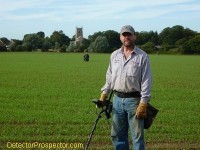Leaderboard
Popular Content
Showing content with the highest reputation on 04/04/2019 in Articles
-
Bertha Creek Gold Panning Area An early prospector named Bertha Creek after his daughter. Hand placer and hydraulic mining began in 1902 and may have yielded up to 600 troy ounces of gold. Most gold came from the alluvial fan below the canyon. Bertha Creek crosses the Seward Highway 2.6 miles south of Turnagain Pass. Lower Bertha Creek lies within a withdrawal that extends for 1,300 feet on either side of the Seward Highway from Turnagain Pass south to Pete’s Creek. Bertha Creek is available for recreational panning from its junction with Granite Creek upstream to the powerline crossing (Map). Granite Creek, however, is closed to recreational mining because of its salmon spawning habitat. Bertha Creek south of Anchorage on the Kenai Peninsula Bertha Creek’s upper portion flows through a glacier-carved valley. Slate bedrock is exposed for 850 feet along the creek, beginning 150 feet above the Seward Highway’s Bertha Creek bridge. A rough trail leads up the east side of the creek. The tan-colored clay layer on bedrock is a good bet for gold that ranges from flaky to nuggety. Single pans have produced gold pieces up to 1/4 inch long. The rust-colored quartz float in the stream bed occasionally contains pyrite cubes and may be the placer gold source. Another trail leaves the highway 250 feet north of the bridge, leading up the northwest side of the creek. At mile 0.2, it passes a bluff overlooking the site where Bertha Creek exits from a narrow steep walled canyon. You can get good colors from stream gravel and fractured bedrock in this area. You can also get gold from nearby Spokane Creek (Map) and Lyon, and Tincan creeks north of Bertha Creek. The withdrawal includes the lower creek portions that are open to recreational panning. An informal pull-off where the Seward Highway crosses Spokane Creek provides parking for 1-2 vehicles. Access Lyon and Tincan creeks from the Turnagain Pass rest area. Parking, camping, and picnic sites are available at Bertha Creek Campground. No motorized vehicles off established roadways in this area. Bertha Creek Public Mining Site Here are a few simple rules and guidelines that all recreational gold panners must know: Recreational gold panning on the Chugach National Forest consists of the use of hand tools, panning, sluicing, and suction dredging with a 4-inch or smaller intake hose. You must follow all National Forest rules, such as camping limits, discharge of firearms, and use of trails. You can find regulations in Title 36 Code of Federal Regulations (CFR), with general prohibitions in part 261. Review these regulations before you go gold panning. You can find copies of these regulations on the Internet and at Chugach National Forest offices in Anchorage, Girdwood, Seward, and Moose Pass. You can use gold pans and hand tools-fed sluice boxes year round in the streams listed in this booklet. No hydraulic mining or use of earth-moving equipment is allowed. Work only the active stream channel or unvegetated gravel bars. Do not dig in stream banks! You are not allowed to build structures, cut trees or dig up archaeological, historical, or paleontological objects, nor are you allowed to obstruct others in their recreational pursuits. If you find those objects, please report them to the Chugach National Forest. Suction dredges (4-inch nozzles or smaller) are permitted from May 15 to July 15 only. Remember that permits are required. The Kenai Peninsula is home to brown and black bears. Stay alert and avoid bears whenever possible. For more information, get Bear Facts from the U.S. Forest Service or Alaska Public Lands Information Centers. The water is cold and you can expect to get wet— after all, the gold is in the water. Wear insulated waterproof boots and gloves. Wool clothing can keep you warm even when wet. Bring extra clothing and dress in layers. Keep Alaska green, do not trash or litter. Many places have a $1,000 fine for littering. Follow Leave No Trace principles. Good luck and good prospecting! Bertha Creek, Alaska in 2014 Most of the information above was derived from GOLD PANNING, Guide to Recreational Gold Panning on the Kenai Peninsula, Chugach National Forest, Alaska (2018) found here - See the full text for more information and details.1 point
-
I recently treated myself to a metal detecting holiday to the area around Colchester, England. This was a reprise to a trip I made to the UK in 2010 in search of Celtic gold. Gold was not in the equation for that trip, but I did find the oldest coins and artifacts I have ever found.... as in 2000 years older than anything I have found before! Colchester has history reaching back into prehistoric times, and is generally acknowledged as the location of Britain's first city. Celtic tribes were active in the area, leaving behind many Celtic gold coins to be found by modern day detectorists. The Romans were also very active in the area, as were other invaders, leading to finds from many cultures across the centuries. I made a return visit to Colchester in 2018, this time relying heavily on the new Minelab Equinox metal detector as my detector of choice. I also had the opportunity to use the new Minelab Equinox 15" x 12" DD coil while on this trip. Not only did I have a very successful trip, but I got to observe other great finds made by the other detectorists in the group. All in all this was a very exciting metal detecting experience that I enjoyed thoroughly. The links below outline both my own experiences and the same trip told from the perspective of another person on the same adventure. Steve's 2018 UK Adventure by Steve Herschbach My UK Trip .... Double Ancient Gold! by Ill Digger Steve Herschbach finds ancient UK gold!1 point


